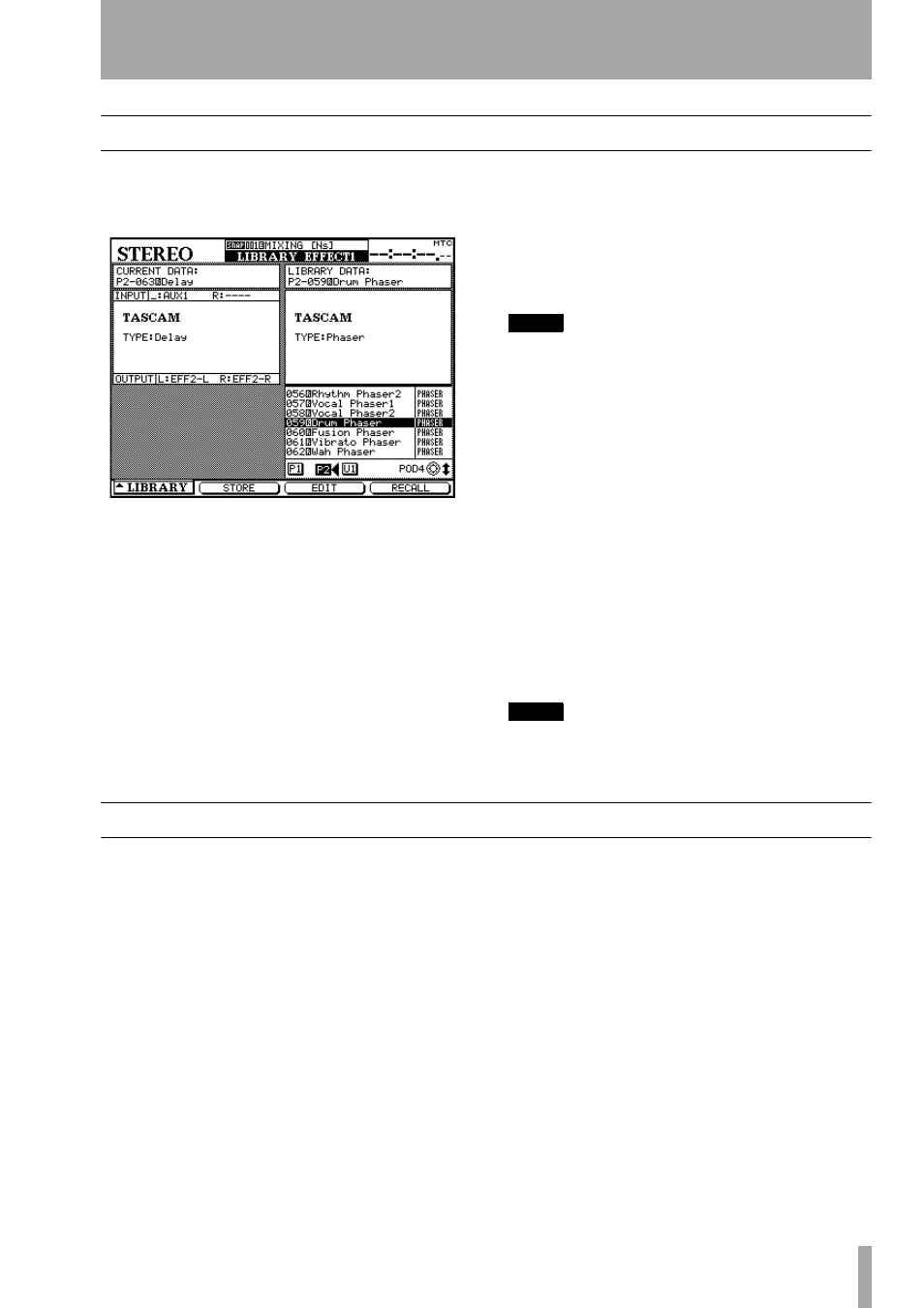Setting up the effects units, Changing parameters, Setting up the effects units changing parameters – Teac DM-24 Effects Manual User Manual
Page 7: 7setting up the effects units

1 – Internal Effects on the DM-24—Setting up the effects units
TASCAM DM-24 Effects
7
Setting up the effects units
To use one of the internal effect units, press the
EFFECT
key and then soft key 2 or soft key 3 (
EFFECT
1
or
EFFECT 2
).
Next, use the
EFF... LIB->
key (soft key 4) to enter the
effects library.
Use the cursor keys and
ENTER
key to select either
one of the two effect preset banks or the user effect
bank.
There are two preset library banks:
• The first bank holds the TC Works reverb preset
settings, as well as blank templates for the Antares
microphone and speaker modelers (“Preset reverb
settings” on page 22).
• The second holds preset TASCAM effect settings
(“Preset effect settings” on page 27).
Use the library screen to scroll through the list of dif-
ferent library entries in the selected bank.
See “Library functions” on page 99 of the main man-
ual for full details regarding library functions.
NOTE
Although the preset library banks are named 1 and 2,
an effect from library bank 1 may be recalled for use
with effect 2, etc., as well as the other way round.
Remember, though, that when using effects in series,
effect 1 always feeds effect 2. If the effect settings are
recalled to the wrong effect, the sound may not be
quite what you expect (echoed reverb is rather differ-
ent from reverbed echo, for example).
When you recall a library entry from the library, a
popup message appears confirming the selection.
When the
EFFECT
key is pressed, the effect screen
showing the values and parameters appropriate for
that particular type of effect is displayed.
Once an entry has been recalled, there is no way of
changing its type through the on-screen parameters.
You must reload an entry of another type from the
library in order to change the effect type.
NOTE
The points at which the effects are returned are set in
the I/O screens and are selectable in the same way as for
mic/line inputs, etc.
Changing parameters
The parameters of the entry are changed using the
cursor keys and PODs, dial and
ENTER
key, in the
same way as other parameters on the DM-24.
These parameter settings take place immediately
(that is, the effect of the change can be heard imme-
diately after the parameter has been changed).
See the appropriate sections of this manual for details
of how the parameters change depending on the
effect type selected.
Essentially, there are two different types of effect: the
in-line type of processor, typically used in an insert
mode, and the send/return type, typically used in a
loop mode (aux send to channel return).
There are no hard and fast rules as to how these
should be used, though. If you wish to use the guitar
amplifier simulator to add an unusual sound to a
string quartet, you are of course free to do so!
Note how all effect screens have a pair of input
meters and a pair of output meters at the top left of
the screen so that the level can be properly adjusted.
The microphone modeler has (in the top row of
PODs) an input and an output level control.
The speaker modeler has (in the top row of PODs) an
input control.
The reverb and the other (TASCAM) effects all have
(in the top row of PODs) an input and output level
control, as well as a mix (wet/dry) control.
